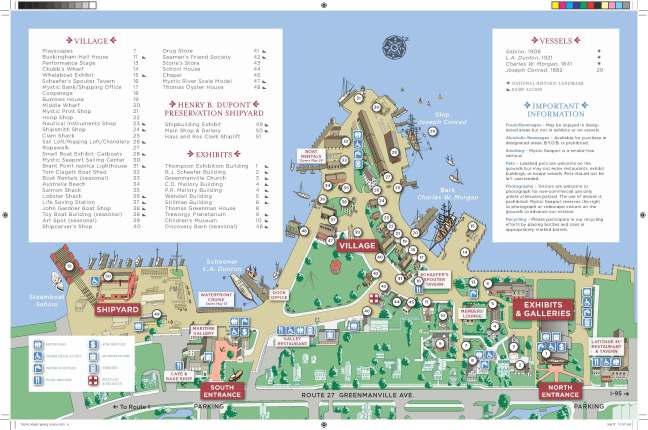When a first-time visitor arrives at the entrance to Mystic Seaport and asks, “what is there to see here?”, the answer is long. It includes a recreated 19th century village, historic watercraft, formal exhibition spaces, a working shipyard, demonstrations, and performances. A few steps could take them from the deck of a 19th century whaling ship to contemporary art, from a blacksmith hammering iron to a shipwright hewing a log, or from a chanteyman singing alongside costumed roleplayers to a deckhand shoveling coal to power a steamboat. Their question could be answered with another question: “what do you want to see?”
Faced with a wide variety of exhibitions, activities, and demonstrations can quickly become overwhelming, especially when a place is new or a topic is unfamiliar. This project offers an opportunity for guided discovery, filtering the available options to provide personalized recommendations.
Goals
- Inspire a deeper connection to demonstrations and objects on view by providing additional context and links between them
- Invite visitors to explore the museum’s resources through an easy to use entry point, linking the new to the familiar
- Provide an intentional method for discovery during a museum visit
- Improve access to map and guide information with an interactive component
How it Works
The project compiles information from visitor input and other users’ activity to provide a pathway for intentional, guided discovery. Recommendations will create a ‘choose your own adventure’ style guide through a museum visit. Visitors will be able to create a profile quickly through a short quiz designed to identify their interests. To further personalize the experience, visitors can choose to enter more information or link their social media accounts, where data about their interests and their friends’ interests can be collected. This can be done online in advance of their visit, in person upon arrival, or throughout their visit on a mobile device.
Tablets stationed in key exhibitions will give those who do not wish to set up a profile a chance to access quick recommendations based on what they just saw in the exhibition (ex: “If you liked this, you may also like…”). The project will use this gathered information to predict what a user will enjoy and find interesting during their visit, helping them personalize their experience. Offering a feature to ‘like’ specific objects will enable the guide to adapt accordingly; the more they use it, the better the predictions will be.
For visitors who seek some guidance while exploring a museum in person, this project will steer them in the right direction, providing recommendations that lead to new discoveries. There is also the potential to layer information within the guide, giving users the chance to learn in more depth through detailed object information.
Target Audience
The target audience age range is 18-49, those most likely to be familiar with and actively use social media. Ideally, they would discover the project in advance in order to take advantage of its predictive features during their visit. This includes:
- Subject matter enthusiasts – those who are involved in the sailing community or are boat builders, visiting in alone or in pairs to do research or learn something new
- Locals and weekend vacationers – tourists travelling from surrounding states or who are local to the area, visiting in groups or pairs
- Parents – families with school-age children who are looking for educational activities for the whole family
Stakeholders
- Collections: must identify relevant metadata, digitize collection information, identify connections between objects, and collaborate with other institutions should the opportunity arise
- IT: help implement and troubleshoot the technology
- Exhibitions: to help design the user interface and execute prototypes
- Education: contribute different engagement techniques for content
- Marketing: to segment targeted audiences and help tailor content
- Development/Board Members: may need to organize fundraising or find a sponsor to fund digitization projects, or developing the necessary technology
- Volunteers and front line staff: will need to be able to use and troubleshoot the app, for any visitor who may have questions
- A lot of the initial technology will likely need to be designed by a third party
- Local historical sites and businesses that have links to objects or locations on the museum grounds
Constraints
Because the functionality of the project depends heavily on user input, its usefulness will depend on how many people use it and the amount of information they provide. Its effectiveness also relies on having essential object data, including images for collection items, available digitally. To facilitate the best experience, the museum should also have sufficient wifi coverage in all exhibition areas.
Success Metrics
Taking the confusion out of wayfinding
- The majority of users report that they were able to orient themselves and navigate quickly and easily
- Front facing staff see a decrease in requests for directions
Inspiring a deeper connection
- Increase in return in-person visitation and online visitation
- Increase in individual giving and number of first time donors
Encouraging discovery
- The majority of users report that they found something new to them or learned something new about a familiar object
About Mystic Seaport
Mystic Seaport is a 19-acre maritime museum that “strives to inspire an enduring connection to the American maritime experience”. Its grounds include a recreated 19th century New England coastal village, a working shipyard, formal exhibit halls, and artifact storage facilities. A visitor can expect to find historic watercraft, working shipwrights and skilled craftspeople, contemporary art, and maritime artifacts on view. Mystic Seaport’s vision is to “significantly influence how new generations engage with our nation’s past, present, and future”.
More information can be found here.



